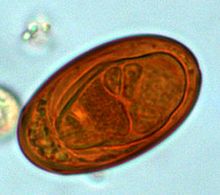Our website is made possible by displaying online advertisements to our visitors.
Please consider supporting us by disabling your ad blocker.
Liver fluke


Liver fluke is a collective name of a polyphyletic group of parasitic trematodes under the phylum Platyhelminthes.[1] They are principally parasites of the liver of various mammals, including humans. Capable of moving along the blood circulation, they can occur also in bile ducts, gallbladder, and liver parenchyma. In these organs, they produce pathological lesions leading to parasitic diseases. They have complex life cycles requiring two or three different hosts, with free-living larval stages in water.[2]
- ^ Lotfy, WM; Brant, SV; DeJong, RJ; Le, TH; Demiaszkiewicz, A; Rajapakse, RP; Perera, VB; Laursen, JR; Loker, ES (2008). "Evolutionary origins, diversification, and biogeography of liver flukes (Digenea, Fasciolidae)". The American Journal of Tropical Medicine and Hygiene. 79 (2): 248–255. doi:10.4269/ajtmh.2008.79.248. PMC 2577557. PMID 18689632.
- ^ Diseases and Disorders Volume 2. Tarrytown, NY: Marshall Cavendish COrporation. 2008. p. 525. ISBN 978-0-7614-7772-3.
Previous Page Next Page


